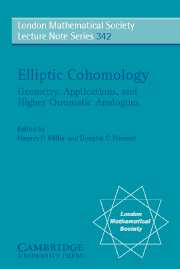Book contents
- Frontmatter
- Contents
- Preface
- Charles Thomas, 1938–2005
- 1 Discrete torsion for the supersingular orbifold sigma genus
- 2 Quaternionic elliptic objects and K3-cohomology
- 3 The M-theory 3-form and E8 gauge theory
- 4 Algebraic groups and equivariant cohomology theories
- 5 Delocalised equivariant elliptic cohomology (with an introduction by Matthew Ando and Haynes Miller)
- 6 On finite resolutions of K(n)-local spheres
- 7 Chromatic phenomena in the algebra of BP*BP-comodules
- 8 Numerical polynomials and endomorphisms of formal group laws
- 9 Thom prospectra for loopgroup representations
- 10 Rational vertex operator algebras
- 11 A possible hierarchy of Morava K-theories
- 12 The motivic Thom isomorphism
- 13 Toward higher chromatic analogs of elliptic cohomology
- 14 What is an elliptic object?
- 15 Spin cobordism, contact structure and the cohomology of p-groups
- 16 Brave New Algebraic Geometry and global derived moduli spaces of ring spectra
- 17 The elliptic genus of a singular variety
14 - What is an elliptic object?
Published online by Cambridge University Press: 03 May 2010
- Frontmatter
- Contents
- Preface
- Charles Thomas, 1938–2005
- 1 Discrete torsion for the supersingular orbifold sigma genus
- 2 Quaternionic elliptic objects and K3-cohomology
- 3 The M-theory 3-form and E8 gauge theory
- 4 Algebraic groups and equivariant cohomology theories
- 5 Delocalised equivariant elliptic cohomology (with an introduction by Matthew Ando and Haynes Miller)
- 6 On finite resolutions of K(n)-local spheres
- 7 Chromatic phenomena in the algebra of BP*BP-comodules
- 8 Numerical polynomials and endomorphisms of formal group laws
- 9 Thom prospectra for loopgroup representations
- 10 Rational vertex operator algebras
- 11 A possible hierarchy of Morava K-theories
- 12 The motivic Thom isomorphism
- 13 Toward higher chromatic analogs of elliptic cohomology
- 14 What is an elliptic object?
- 15 Spin cobordism, contact structure and the cohomology of p-groups
- 16 Brave New Algebraic Geometry and global derived moduli spaces of ring spectra
- 17 The elliptic genus of a singular variety
Summary
ELLIPTIC COHOMOLOGY
A generalized cohomology theory is a sequence of contravariant functors {hi}i∈ℤ from spaces to abelian groups which are linked together in a well-known way. The theories that arise in nature are of two types: K-theories, and cobordism theories. (Classical cohomology can be approached in so many different ways that I shall leave it aside for the moment.)
On a compact space X the isomorphism classes of complex vector bundles form an abelian semigroup Vect(X) under the operation of direct sum, and K0(X) is the abelian group got by formally adjoining inverses to the semigroup Vect(X). Then K0 is a homotopy functor, and the functors K−i, for i > 0, defined — roughly — by composing K0 with the i-fold suspension functor, have the properties of “half” a cohomology theory. That much is true for any representable homotopy functor, but the functors Ki are special because of the Bott periodicity theorem, which gives a canonical equivalence between Ki and Ki−2 for i ≤ 0, and enables us to define Ki for all i ∈ ℤ by periodicity.
There is a completely different reason, however, unrelated to Bott periodicity, why the functor K0 forms part of a cohomology theory, and it applies in a much more general context. For any (discrete) ring A we have a contravariant functor X ↦ ModA(X), where ModA(X) is the semigroup of isomorphism classes of bundles of finitely generated projective A-modules on X. It is a representable homotopy functor, though not a very interesting one, as it sees only the fundamental group of X.
- Type
- Chapter
- Information
- Elliptic CohomologyGeometry, Applications, and Higher Chromatic Analogues, pp. 306 - 317Publisher: Cambridge University PressPrint publication year: 2007
- 4
- Cited by



